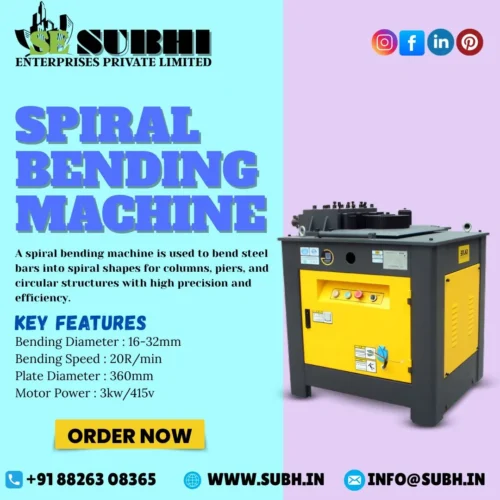WHAT IS SPIRAL BENDING MACHINE?
A spiral bending machine is a type of construction equipment used to bend materials, typically metal, into spiral shapes. These machines are particularly useful in various construction and manufacturing processes where spiral forms are needed, such as in the creation of spiral staircases, coils, or curved structural components
Spiral bending machines and bar bending machines are both used to bend metal bars, typically for construction purposes, but they serve different functions and are designed differently. Here’s a comparison of the two:
SPIRAL BENDING MACHINE
BAR RING BENDING MACHINE
Purpose:
Specifically designed to create spiral or helical shapes from metal bars.
Commonly used to make spirals for reinforcing columns, spiral staircases, coils, and other curved structures.
Bending Process:
Bends bars into a continuous spiral with a consistent diameter and pitch.
Typically involves a set of rollers or a bending die that rotates the bar into a spiral shape.
Material Handling:
Can handle bars of various diameters, depending on the machine’s capacity.
Often used with materials like TMT bars, steel rods, or other ductile metals.
Adjustability:
Allows for precise adjustment of the spiral diameter and pitch.
Designed to produce consistent, continuous shapes with high accuracy.
Applications:
Ideal for creating helical reinforcement for concrete structures, spiral staircases, and other architectural elements requiring a continuous curved form.
Purpose:
Designed to bend metal bars to specific angles or shapes, typically for rebar used in reinforced concrete structures.
Commonly used for making standard bends like hooks, stirrups, 90-degree angles, and U-shapes.
Bending Process:
Bends bars to precise angles as per design requirements.
Utilizes a bending pin and a counter pin to hold and bend the bar to the desired angle.
Material Handling:
Capable of bending bars of varying thicknesses and lengths.
Primarily used for straight bars that need to be bent at specific points rather than into continuous shapes.
Adjustability:
Offers precise control over the angle and position of the bend.
Machines can be set to produce a range of standard and custom bend angles.
Applications:
Widely used in construction for shaping rebar for concrete reinforcement in foundations, beams, columns, and slabs.
Can also be used in fabrication for other metalworking applications requiring bent metal components.

Key Differences
(1.) Shape Output:
(a.) Spiral bending machines create continuous spiral shapes.
(b.) Bar bending machines create discrete bends at specific angles.
(2.) Design and Mechanism:
(a.) Spiral bending machines have mechanisms for continuously feeding and rotating the bar to create spirals.
(b.)Bar bending machines have mechanisms to bend bars at a fixed position to a specific angle.
(3.) Use Case:
(a.) Spiral bending machines are specialized for spiral formations, while bar bending machines are versatile for a range of bending needs.
(4.) Adjustability and Precision:
(a.) Spiral machines focus on adjusting spiral diameter and pitch, whereas bar machines focus on bending angle and position.
